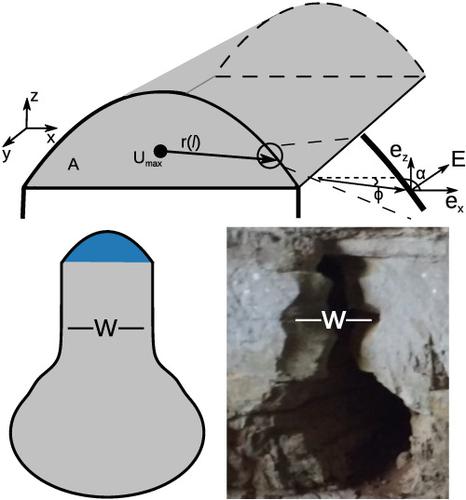当前位置:
X-MOL 学术
›
Earth Surf.Process. Land.
›
论文详情
Our official English website, www.x-mol.net, welcomes your
feedback! (Note: you will need to create a separate account there.)
Modeling cave cross‐section evolution including sediment transport and paragenesis
Earth Surface Processes and Landforms ( IF 2.8 ) Pub Date : 2020-08-13 , DOI: 10.1002/esp.4915 Max P. Cooper 1 , Matthew D. Covington 1
Earth Surface Processes and Landforms ( IF 2.8 ) Pub Date : 2020-08-13 , DOI: 10.1002/esp.4915 Max P. Cooper 1 , Matthew D. Covington 1
Affiliation

|
Deposits within caves are often used to interpret past landscape evolution and climate conditions. However, cave passage shapes also preserve information about past conditions. Despite the usefulness of passage shape, no previous models simulate cave cross‐section evolution in a realistic manner. Here we develop a model for evolving cave passage cross‐sections using a shear stress estimation algorithm and a shear stress erosion rule. Our model qualitatively duplicates observed cave passage shapes so long as erosion rates vary with shear stress, as in the case of transport limited dissolution or mechanical erosion. This result provides further evidence that erosion rates within caves are not typically limited by surface reaction rates, even though current speleogenesis models predict surface‐rate limitation under most turbulent flow conditions. By adding sediment transport and alluviation to the model we successfully simulate paragenetic channels. Simulations duplicate the hypothesized dynamics of paragenesis, whereby: 1) the cross‐section of a phreatic passage grows until shear stress is sufficiently reduced that alluviation occurs, 2) the floor of the passage becomes armored and erosion continues on the ceiling and walls, 3) negative feedback produces an equilibrium cross‐sectional area such that shear stress is sufficient to transport incoming sediment. We derive an approximate scaling relationship that indicates that equilibrium paragenetic channel width scales with the square root of discharge, and weakly with the inverse of sediment supply. Simulations confirm this relationship and show that erosion mechanism, sediment size, and roughness are secondary controls. The inverse scaling of width with sediment supply in paragenetic channels contrasts with surface bedrock channels, which respond to larger sediment supplies by widening. Our model provides a first step in simulating cave cross‐section evolution and points to the need for a better understanding of the dominant erosion mechanisms in soluble bedrock channels. © 2020 John Wiley & Sons, Ltd.
中文翻译:

模拟洞穴横截面演化,包括沉积物迁移和共生
洞穴内的沉积物通常被用来解释过去的景观演变和气候条件。但是,洞穴通道的形状也会保留有关过去状况的信息。尽管通道形状有用,但以前的模型都没有以逼真的方式模拟洞穴横截面的演变。在这里,我们使用切应力估算算法和切应力侵蚀规则为溶洞通道横截面开发了一个模型。只要侵蚀速率随剪切应力而变化,我们的模型就可以定性地复制观察到的洞穴通道形状,例如在运输受限的溶解或机械侵蚀的情况下。该结果提供了进一步的证据,即使当前的成因模型预测了大多数湍流条件下的表面速率限制,洞穴内的侵蚀速率通常不受表面反应速率的限制。通过向模型中添加泥沙输送和冲积,我们成功地模拟了同生通道。模拟复制了假设的共生动力学,其中:1)潜水通道的横截面增大,直到剪切应力充分减小以致发生冲积; 2)通道的地板铠装,并且天花板和墙壁上的侵蚀继续,3 )负反馈会产生一个平衡的横截面,使得剪切应力足以运输进入的沉积物。我们得出一个近似的比例关系,表明平衡的共生河道宽度与流量的平方根成比例,而与沉积物供应量成反比。模拟证实了这种关系,并表明侵蚀机理,沉积物大小和粗糙度是次要控制因素。共生河道中的泥沙供应与宽度成反比,而表层基岩河床则与之相反,后者通过拓宽对更大的泥沙供应作出反应。我们的模型为模拟洞穴断面演化提供了第一步,并指出需要更好地了解可溶性基岩河道的主要侵蚀机制。分级为4 +©2020 John Wiley&Sons,Ltd.
更新日期:2020-08-13
中文翻译:

模拟洞穴横截面演化,包括沉积物迁移和共生
洞穴内的沉积物通常被用来解释过去的景观演变和气候条件。但是,洞穴通道的形状也会保留有关过去状况的信息。尽管通道形状有用,但以前的模型都没有以逼真的方式模拟洞穴横截面的演变。在这里,我们使用切应力估算算法和切应力侵蚀规则为溶洞通道横截面开发了一个模型。只要侵蚀速率随剪切应力而变化,我们的模型就可以定性地复制观察到的洞穴通道形状,例如在运输受限的溶解或机械侵蚀的情况下。该结果提供了进一步的证据,即使当前的成因模型预测了大多数湍流条件下的表面速率限制,洞穴内的侵蚀速率通常不受表面反应速率的限制。通过向模型中添加泥沙输送和冲积,我们成功地模拟了同生通道。模拟复制了假设的共生动力学,其中:1)潜水通道的横截面增大,直到剪切应力充分减小以致发生冲积; 2)通道的地板铠装,并且天花板和墙壁上的侵蚀继续,3 )负反馈会产生一个平衡的横截面,使得剪切应力足以运输进入的沉积物。我们得出一个近似的比例关系,表明平衡的共生河道宽度与流量的平方根成比例,而与沉积物供应量成反比。模拟证实了这种关系,并表明侵蚀机理,沉积物大小和粗糙度是次要控制因素。共生河道中的泥沙供应与宽度成反比,而表层基岩河床则与之相反,后者通过拓宽对更大的泥沙供应作出反应。我们的模型为模拟洞穴断面演化提供了第一步,并指出需要更好地了解可溶性基岩河道的主要侵蚀机制。分级为4 +©2020 John Wiley&Sons,Ltd.











































 京公网安备 11010802027423号
京公网安备 11010802027423号